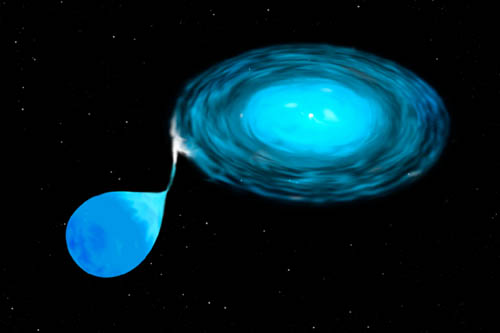Artist interpretation of NGC6624 (Produced by: Dana Berry/STScI) This is an illustration of a double star system at the heart of the globular cluster NGC 6624, located approximately 28,000 light-years away in the constellation Sagittarius. The star is a source of powerful bursts of X-ray emission. One member of the binary is a neutron star, an extremely dense and compact corpse of a massive star that exploded long ago. The neutron star is slowly devouring its larger but less-massive white- dwarf star companion, seen at lower left. Tidal forces from the neutron star's intense gravitation pull stretch the dwarf into an egg-shape. (A white dwarf is the remnant of a burned out Sun-like star.) Gas pulled from the dwarf flows across a narrow accretion bridge and then smear out into a swirling disk. The energy released by the continuous infall of gas onto the neutron star produces the steady X-ray emission. This gusher of radiation heats temperatures greater than 100,000 degrees Fahrenheit. The infall also supplies fuel for sporadic, intense X-ray bursts. These occur when enough gas accumulates on the surface of the neutron star to ignite spontaneously, creating an enormous nuclear fusion bomb. For a few seconds, the outburst abruptly outshines the usual steady X-ray emission. Click here for a larger gif.
IMAGES |
By Mission |
Stars |
HEASARC Home | Observatories | Archive | Calibration | Software | Tools | Students/Teachers/Public Last modified: Thursday, 26-Jun-2003 13:48:45 EDT HEASARC Staff Scientist Position - Applications are now being accepted for a Staff Scientist with significant experience and interest in the technical aspects of astrophysics research, to work in the High Energy Astrophysics Science Archive Research Center (HEASARC) at NASA Goddard Space Flight Center (GSFC) in Greenbelt, MD. Refer to the AAS Job register for full details. |

